Related Research Articles

Hernán Cortés de Monroy y Pizarro Altamirano, 1st Marquess of the Valley of Oaxaca was a Spanish conquistador who led an expedition that caused the fall of the Aztec Empire and brought large portions of what is now mainland Mexico under the rule of the King of Castile in the early 16th century. Cortés was part of the generation of Spanish explorers and conquistadors who began the first phase of the Spanish colonization of the Americas.
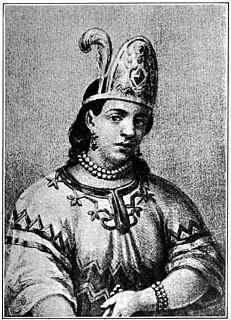
Marina[maˈɾina] or Malintzin[maˈlintsin], more popularly known as La Malinche[la maˈlintʃe], a Nahua woman from the Mexican Gulf Coast, became known for contributing to the Spanish conquest of the Aztec Empire (1519–1521), by acting as an interpreter, advisor, and intermediary for the Spanish conquistador Hernán Cortés. She was one of 20 enslaved women given to the Spaniards in 1519 by the natives of Tabasco. Cortés chose her as a consort, and she later gave birth to his first son, Martín – one of the first Mestizos.
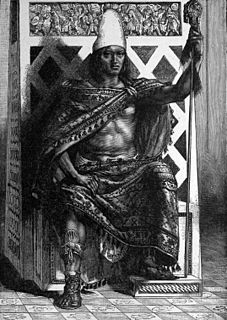
Moctezuma Xocoyotzin [moteːkʷˈsoːma ʃoːkoˈjoːtsin] modern Nahuatl pronunciation (help·info)), variant spellings include Motecuhzomatzin, Montezuma, Moteuczoma, Motecuhzoma, Motēuczōmah, Muteczuma, and referred to retroactively in European sources as Moctezuma II, was the ninth Tlatoani of Tenochtitlan and the sixth Huey Tlatoani or Emperor of the Aztec Empire, reigning from 1502 or 1503 to 1520.

Tenochtitlan, also known as Mexico-Tenochtitlan, was a large Mexica altepetl in what is now the historic center of Mexico City. The exact date of the founding of the city is unclear. The date 13 March 1325 was chosen in 1925 to celebrate the 600th anniversary of the city. The city was built on an island in what was then Lake Texcoco in the Valley of Mexico. The city was the capital of the expanding Aztec Empire in the 15th century until it was captured by the Spanish in 1521.
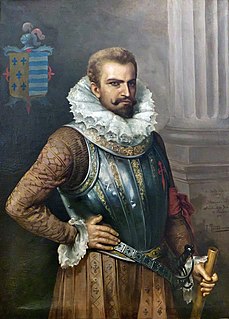
Pedro de Alvarado y Contreras was a Spanish conquistador and governor of Guatemala. He participated in the conquest of Cuba, in Juan de Grijalva's exploration of the coasts of the Yucatán Peninsula and the Gulf of Mexico, and in the conquest of Mexico led by Hernán Cortés. He is considered the conquistador of much of Central America, including Guatemala, Honduras and El Salvador. Although renowned for his skill as a soldier, Alvarado is known also for the cruelty of his treatment of native populations, and mass murders committed in the subjugation of the native peoples of Mexico and Guatemala.

Bernal Díaz del Castillo was a Spanish conquistador, who participated as a soldier in the conquest of Mexico under Hernán Cortés and late in his life wrote an account of the events. As an experienced soldier of fortune, he had already participated in expeditions to Tierra Firme, Cuba, and to Yucatán before joining Cortés. In his later years he was an encomendero and governor in Guatemala where he wrote his memoirs called The True History of the Conquest of New Spain. He began his account of the conquest almost thirty years after the events and later revised and expanded it in response to the biography published by Cortes's chaplain Francisco López de Gómara, which he considered to be largely inaccurate in that it did not give due recognition to the efforts and sacrifices of others in the Spanish expedition.

Bernardino de Sahagún was a Franciscan friar, missionary priest and pioneering ethnographer who participated in the Catholic evangelization of colonial New Spain. Born in Sahagún, Spain, in 1499, he journeyed to New Spain in 1529. He learned Nahuatl and spent more than 50 years in the study of Aztec beliefs, culture and history. Though he was primarily devoted to his missionary task, his extraordinary work documenting indigenous worldview and culture has earned him the title as “the first anthropologist." He also contributed to the description of the Aztec language Nahuatl. He translated the Psalms, the Gospels, and a catechism into Nahuatl.

Historia verdadera de la conquista de la Nueva España is a first-person narrative written in 1568 by military adventurer, conquistador, and colonist settler Bernal Díaz del Castillo (1492–1584), who served in three Mexican expeditions; those of Francisco Hernández de Córdoba (1517) to the Yucatán peninsula; the expedition of Juan de Grijalva (1518), and the expedition of Hernán Cortés (1519) in the Valley of Mexico; the history relates his participation in the fall of Emperor Moctezuma II, and the subsequent defeat of the Aztec Empire.

The Fall of Tenochtitlan, the capital of the Aztec Empire, was a decisive event in the Spanish conquest of the empire. It occurred in 1521 following extensive manipulation of local factions and exploitation of pre-existing political divisions by Spanish conquistador Hernán Cortés. He was aided by indigenous allies, and his interpreter and companion La Malinche.

The Aztec Empire or the Triple Alliance was an alliance of three Nahua altepetl city-states: Mexico-Tenochtitlan, Tetzcoco, and Tlacopan. These three city-states ruled that area in and around the Valley of Mexico from 1428 until the combined forces of the Spanish conquistadores and their native allies who ruled under Hernán Cortés defeated them in 1521.

La Noche Triste was an important event during the Spanish conquest of the Aztec Empire, wherein Hernán Cortés, his army of Spanish conquistadors, and their native allies were driven out of the Aztec capital, Tenochtitlan.

The Aztecs were a Pre-Columbian Mesoamerican people of central Mexico in the 14th, 15th, and 16th centuries. They called themselves Mēxihcah.

Human sacrifice was common in many parts of Mesoamerica, so the rite was nothing new to the Aztecs when they arrived at the Valley of Mexico, nor was it something unique to pre-Columbian Mexico. Other Mesoamerican cultures, such as the Purépechas and Toltecs, and the Maya performed sacrifices as well and from archaeological evidence, it probably existed since the time of the Olmecs, and perhaps even throughout the early farming cultures of the region. However, the extent of human sacrifice is unknown among several Mesoamerican civilizations. What distinguished Maya and Aztec human sacrifice was the way in which it was embedded in everyday life and believed to be a necessity. These cultures also notably sacrificed elements of their own population to the gods.

The Spanish conquest of the Aztec Empire, also known as the Conquest of Mexico or the Spanish-Aztec War (1519–21), was one of the primary events in the Spanish colonization of the Americas. There are multiple 16th-century narratives of the events by Spanish conquistadors, their indigenous allies, and the defeated Aztecs. It was not solely a contest between a small contingent of Spaniards defeating the Aztec Empire but rather the creation of a coalition of Spanish invaders with tributaries to the Aztecs, and most especially the Aztecs' indigenous enemies and rivals. They combined forces to defeat the Mexica of Tenochtitlan over a two-year period. For the Spanish, the expedition to Mexico was part of a project of Spanish colonization of the New World after twenty-five years of permanent Spanish settlement and further exploration in the Caribbean.

The Battle of Otumba was fought between the Aztec and allied forces led by the Cihuacoatl Matlatzincátzin and those of Hernán Cortés made up of the Spanish conquerors and Tlaxcalan allies, which took place on July 7, 1520 in Temalcatitlán, a plain near Otumba during the development of the Conquest of Mexico. The result of the battle was a victory for the Spanish, which allowed Cortés to reorganize his army, having suffered casualties a few days before in the episode known as La Noche Triste. A year later, by reinforcing his army with new men and supplies, and creating alliances with the indigenous peoples who had been subjugated by the Aztec, Cortés managed to besiege and conquer Tenochtitlan.
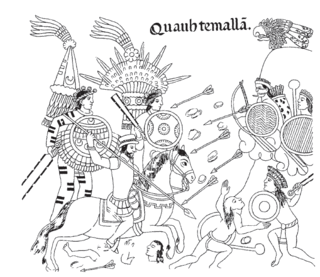
Indian auxiliaries or indios auxiliares is the term used in old Spanish chronicles and historical texts for the indigenous peoples who were integrated into the armies of the Spanish conquistadors with the purpose of supporting their advance and combat operations during the Conquest of America. They acted as guides, translators, or porters and in this role were also called yanakuna, particularly within the old Inca Empire and Chile. The term was also used for formations composed of indigenous warriors or Indios amigos, which they used for reconnaissance, combat, and as reserve in battle. The auxiliary Indians remained in use after the conquest, during some revolts, in border zones and permanent military areas, as in Chile in the Arauco War.
Qualpopoca was an Aztec administrator and military commander whose operations on behalf of the Aztec Emperor Moctezuma Xocoyotzin against the Spanish conquistadors at Nautla prompted the crisis in Aztec-Spanish relations that provided Hernán Cortés with the pretext he needed to capture Moctezuma and overthrow the Aztec state. Qualpopoca had killed and captured a number of conquistadors in a battle close to Nauhtla after a dispute about tribute, and thus was the first Aztec commanders to have any success against the Spanish. In revenge, Cortes forced the captive Moctezuma to order his arrest, return him to the Aztec capital Tenochtitlan and subsequently burn him alive in front of the Templo Mayor.
Francisco de Aguilar, born Alonso de Aguilar, was a Spanish conquistador who took part in the expedition led by Hernán Cortés that resulted in the conquest of the Aztec Empire and the fall of Tenochtitlan, the capital of the Aztec state in the central Mexican plateau.

Cē Ācatl Topiltzin Quetzalcoatl is a mythologised figure appearing in 16th-century accounts of Nahua historical traditions, where he is identified as a ruler in the 10th century of the Toltecs— by Aztec tradition their predecessors who had political control of the Valley of Mexico and surrounding region several centuries before the Aztecs themselves settled there.
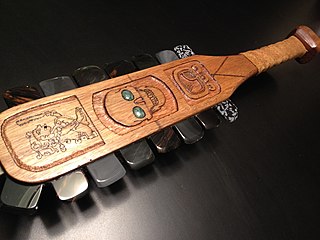
A macuahuitl is a weapon, a wooden club with several embedded obsidian blades. The name is derived from the Nahuatl language and means "hand-wood". Its sides are embedded with prismatic blades traditionally made from obsidian. Obsidian is capable of producing an edge sharper than high quality steel razor blades. The macuahuitl was a standard close combat weapon.
References
- ↑ Altman, Ida (2003). The Early History of Greater Mexico. Upper Saddle River, NJ. p. 75.